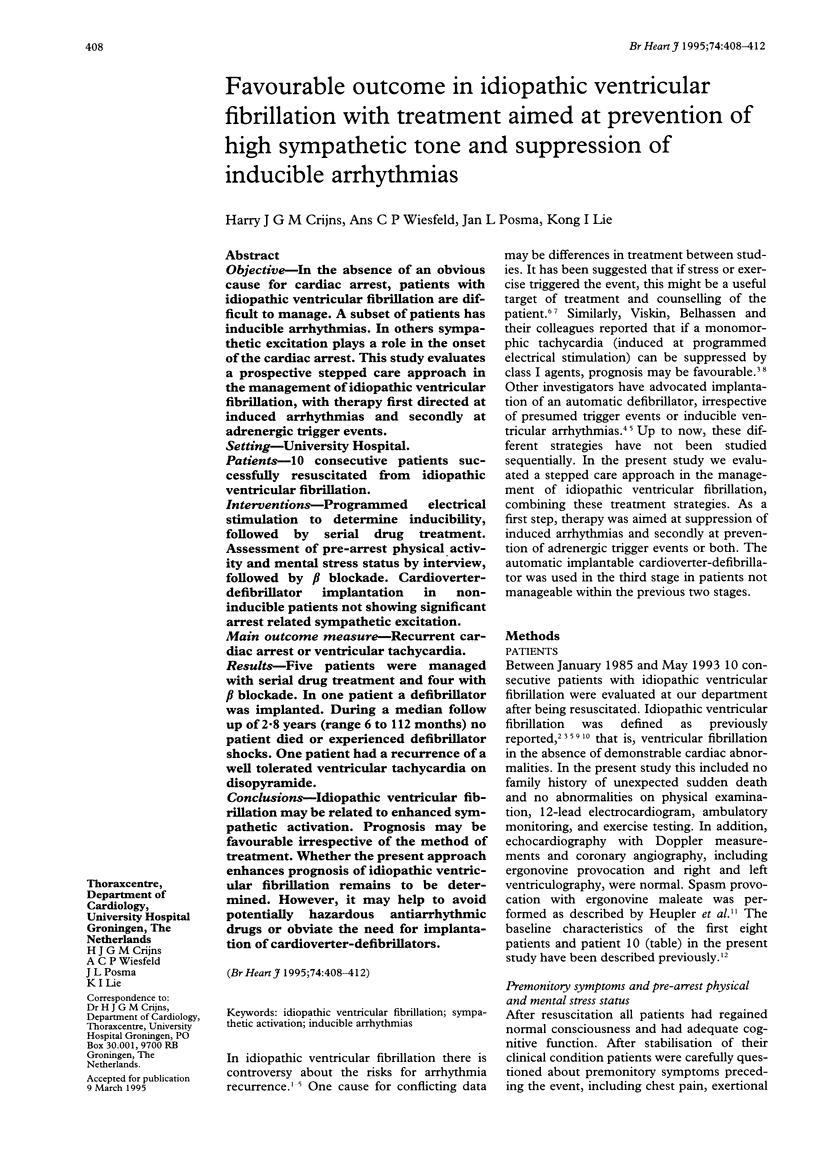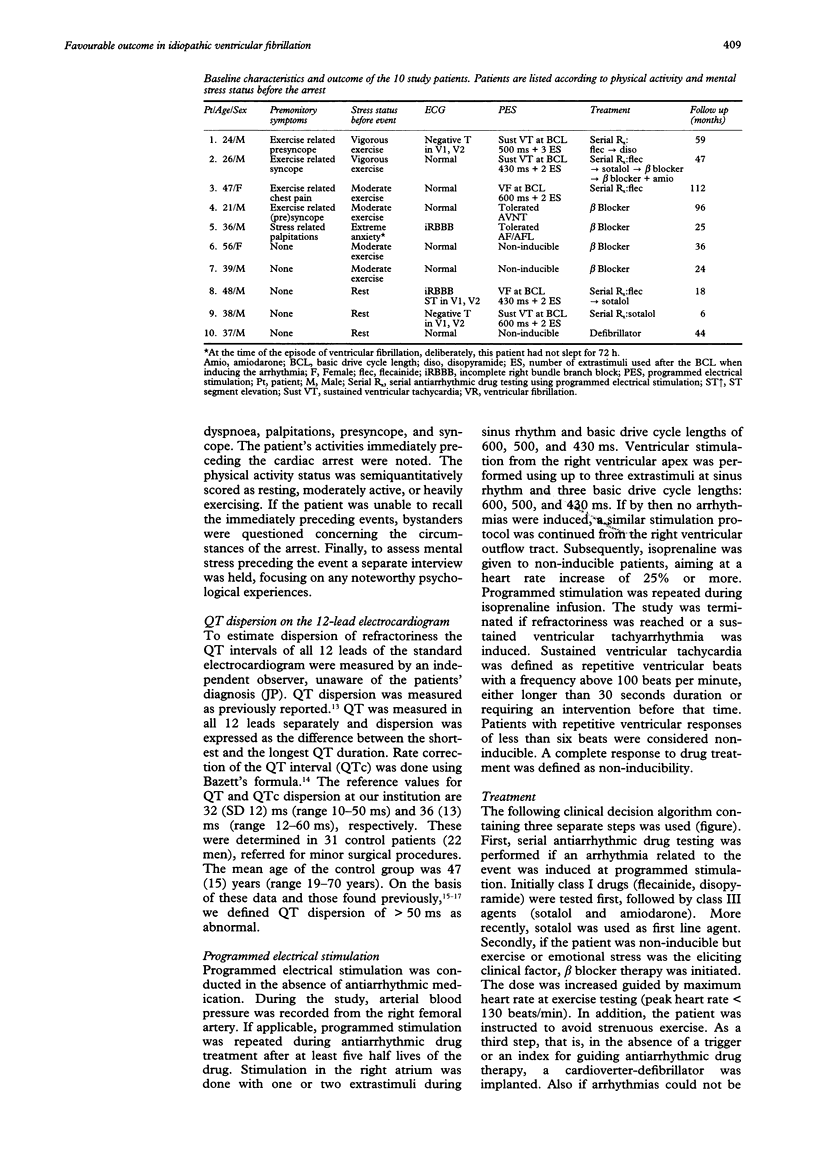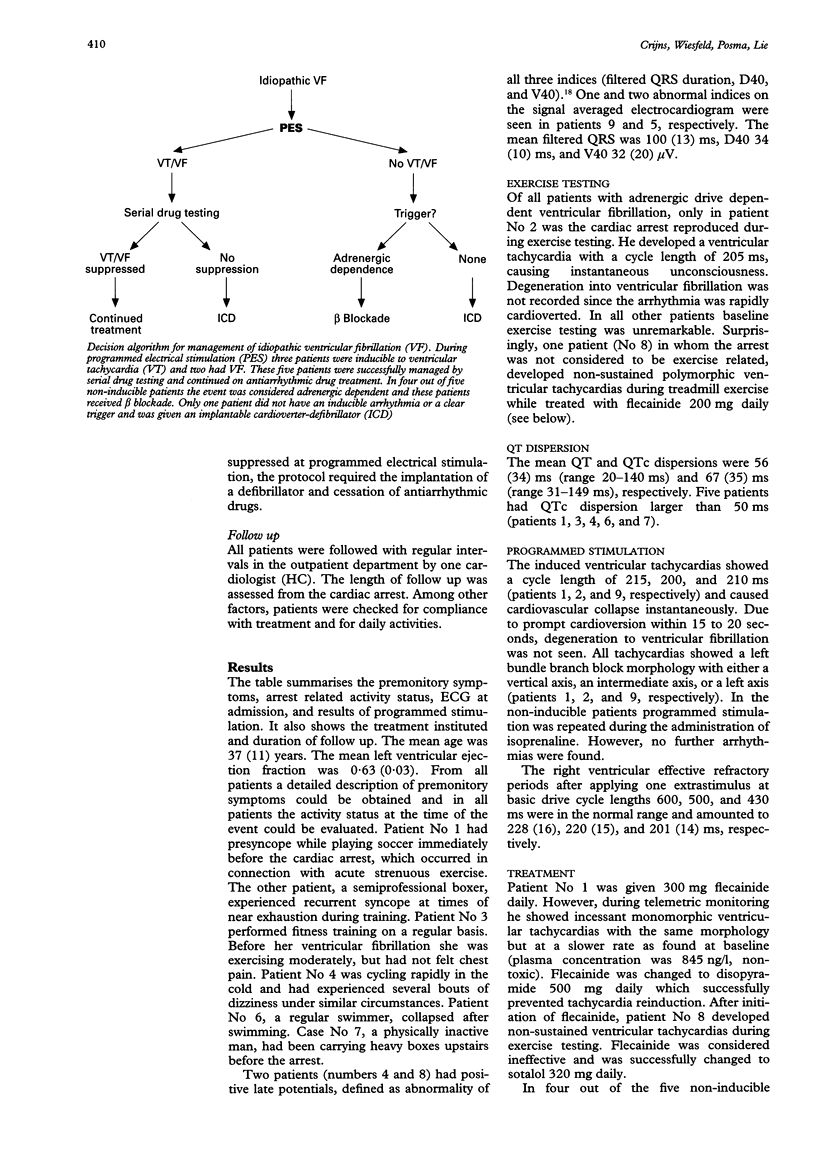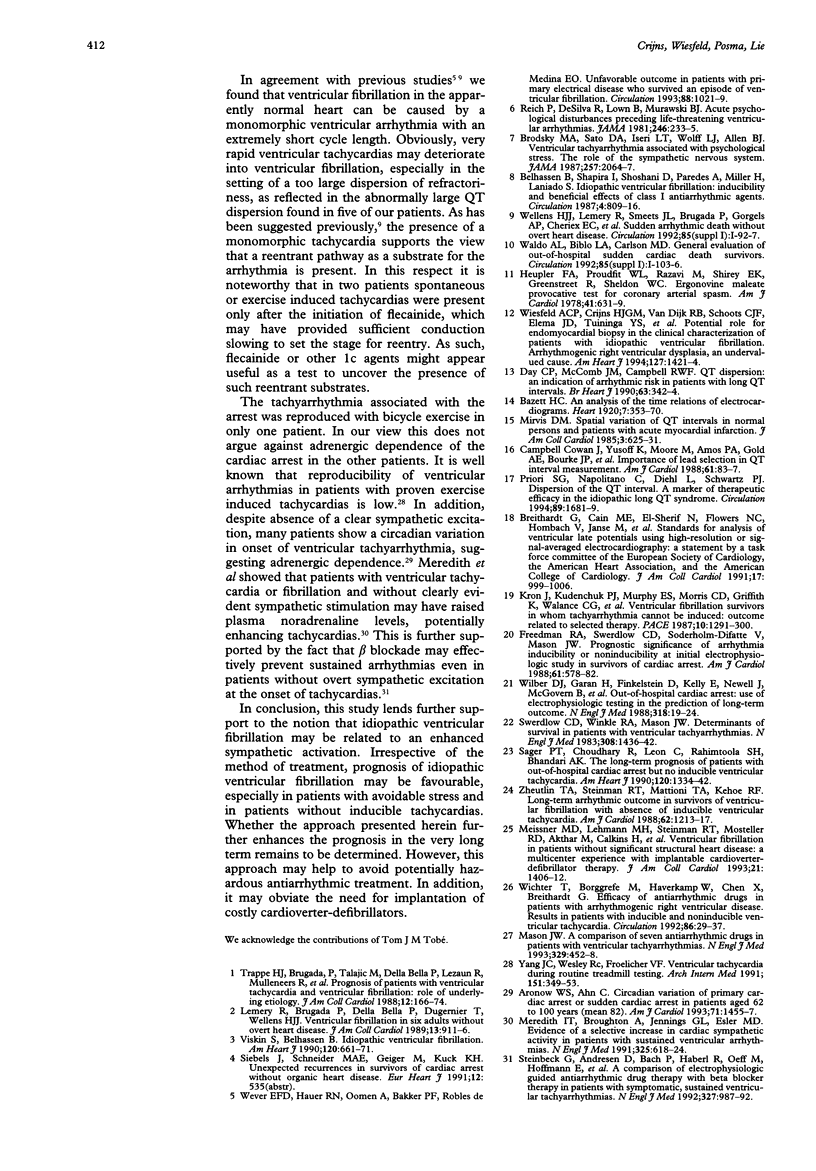Abstract
OBJECTIVE--In the absence of an obvious cause for cardiac arrest, patients with idiopathic ventricular fibrillation are difficult to manage. A subset of patients has inducible arrhythmias. In others sympathetic excitation plays a role in the onset of the cardiac arrest. This study evaluates a prospective stepped care approach in the management of idiopathic ventricular fibrillation, with therapy first directed at induced arrhythmias and secondly at adrenergic trigger events. SETTING--University Hospital. PATIENTS--10 consecutive patients successfully resuscitated from idiopathic ventricular fibrillation. INTERVENTIONS--Programmed electrical stimulation to determine inducibility, followed by serial drug treatment. Assessment of pre-arrest physical activity and mental stress status by interview, followed by beta blockade. Cardioverter-defibrillator implantation in non-inducible patients not showing significant arrest related sympathetic excitation. MAIN OUTCOME MEASURE--Recurrent cardiac arrest or ventricular tachycardia. RESULTS--Five patients were managed with serial drug treatment and four with beta blockade. In one patient a defibrillator was implanted. During a median follow up of 2.8 years (range 6 to 112 months) no patient died or experienced defibrillator shocks. One patient had a recurrence of a well tolerated ventricular tachycardia on disopyramide. CONCLUSIONS--Idiopathic ventricular fibrillation may be related to enhanced sympathetic activation. Prognosis may be favourable irrespective of the method of treatment. Whether the present approach enhances prognosis of idiopathic ventricular fibrillation remains to be determined. However, it may help to avoid potentially hazardous antiarrhythmic drugs or obviate the need for implantation of cardioverter-defibrillators.
Full text
PDF




Selected References
These references are in PubMed. This may not be the complete list of references from this article.
- Aronow W. S., Ahn C. Circadian variation of primary cardiac arrest or sudden cardiac death in patients aged 62 to 100 years (mean 82). Am J Cardiol. 1993 Jun 15;71(16):1455–1456. doi: 10.1016/0002-9149(93)90612-g. [DOI] [PubMed] [Google Scholar]
- Belhassen B., Shapira I., Shoshani D., Paredes A., Miller H., Laniado S. Idiopathic ventricular fibrillation: inducibility and beneficial effects of class I antiarrhythmic agents. Circulation. 1987 Apr;75(4):809–816. doi: 10.1161/01.cir.75.4.809. [DOI] [PubMed] [Google Scholar]
- Breithardt G., Cain M. E., el-Sherif N., Flowers N. C., Hombach V., Janse M., Simson M. B., Steinbeck G. Standards for analysis of ventricular late potentials using high-resolution or signal-averaged electrocardiography: a statement by a task force committee of the European Society of Cardiology, the American Heart Association, and the American College of Cardiology. J Am Coll Cardiol. 1991 Apr;17(5):999–1006. doi: 10.1016/0735-1097(91)90822-q. [DOI] [PubMed] [Google Scholar]
- Brodsky M. A., Sato D. A., Iseri L. T., Wolff L. J., Allen B. J. Ventricular tachyarrhythmia associated with psychological stress. The role of the sympathetic nervous system. JAMA. 1987 Apr 17;257(15):2064–2067. [PubMed] [Google Scholar]
- Cowan J. C., Yusoff K., Moore M., Amos P. A., Gold A. E., Bourke J. P., Tansuphaswadikul S., Campbell R. W. Importance of lead selection in QT interval measurement. Am J Cardiol. 1988 Jan 1;61(1):83–87. doi: 10.1016/0002-9149(88)91309-4. [DOI] [PubMed] [Google Scholar]
- Day C. P., McComb J. M., Campbell R. W. QT dispersion: an indication of arrhythmia risk in patients with long QT intervals. Br Heart J. 1990 Jun;63(6):342–344. doi: 10.1136/hrt.63.6.342. [DOI] [PMC free article] [PubMed] [Google Scholar]
- Freedman R. A., Swerdlow C. D., Soderholm-Difatte V., Mason J. W. Prognostic significance of arrhythmia inducibility or noninducibility at initial electrophysiologic study in survivors of cardiac arrest. Am J Cardiol. 1988 Mar 1;61(8):578–582. doi: 10.1016/0002-9149(88)90768-0. [DOI] [PubMed] [Google Scholar]
- Heupler F. A., Jr, Proudfit W. L., Razavi M., Shirey E. K., Greenstreet R., Sheldon W. C. Ergonovine maleate provocative test for coronary arterial spasm. Am J Cardiol. 1978 Apr;41(4):631–640. doi: 10.1016/0002-9149(78)90810-x. [DOI] [PubMed] [Google Scholar]
- Kiowski W., Linder L., Kleinbloesem C., van Brummelen P., Bühler F. R. Blood pressure control by the renin-angiotensin system in normotensive subjects. Assessment by angiotensin converting enzyme and renin inhibition. Circulation. 1992 Jan;85(1):1–8. doi: 10.1161/01.cir.85.1.1. [DOI] [PubMed] [Google Scholar]
- Kiowski W., Linder L., Kleinbloesem C., van Brummelen P., Bühler F. R. Blood pressure control by the renin-angiotensin system in normotensive subjects. Assessment by angiotensin converting enzyme and renin inhibition. Circulation. 1992 Jan;85(1):1–8. doi: 10.1161/01.cir.85.1.1. [DOI] [PubMed] [Google Scholar]
- Kron J., Kudenchuk P. J., Murphy E. S., Morris C. D., Griffith K., Walance C. G., McAnulty J. H. Ventricular fibrillation survivors in whom tachyarrhythmia cannot be induced: outcome related to selected therapy. Pacing Clin Electrophysiol. 1987 Nov;10(6):1291–1300. doi: 10.1111/j.1540-8159.1987.tb04965.x. [DOI] [PubMed] [Google Scholar]
- Lemery R., Brugada P., Della Bella P., Dugernier T., Wellens H. J. Ventricular fibrillation in six adults without overt heart disease. J Am Coll Cardiol. 1989 Mar 15;13(4):911–916. doi: 10.1016/0735-1097(89)90235-0. [DOI] [PubMed] [Google Scholar]
- Mason J. W. A comparison of seven antiarrhythmic drugs in patients with ventricular tachyarrhythmias. Electrophysiologic Study versus Electrocardiographic Monitoring Investigators. N Engl J Med. 1993 Aug 12;329(7):452–458. doi: 10.1056/NEJM199308123290702. [DOI] [PubMed] [Google Scholar]
- Meissner M. D., Lehmann M. H., Steinman R. T., Mosteller R. D., Akhtar M., Calkins H., Cannom D. S., Epstein A. E., Fogoros R. N., Liem L. B. Ventricular fibrillation in patients without significant structural heart disease: a multicenter experience with implantable cardioverter-defibrillator therapy. J Am Coll Cardiol. 1993 May;21(6):1406–1412. doi: 10.1016/0735-1097(93)90317-t. [DOI] [PubMed] [Google Scholar]
- Meredith I. T., Broughton A., Jennings G. L., Esler M. D. Evidence of a selective increase in cardiac sympathetic activity in patients with sustained ventricular arrhythmias. N Engl J Med. 1991 Aug 29;325(9):618–624. doi: 10.1056/NEJM199108293250905. [DOI] [PubMed] [Google Scholar]
- Mirvis D. M. Spatial variation of QT intervals in normal persons and patients with acute myocardial infarction. J Am Coll Cardiol. 1985 Mar;5(3):625–631. doi: 10.1016/s0735-1097(85)80387-9. [DOI] [PubMed] [Google Scholar]
- Priori S. G., Napolitano C., Diehl L., Schwartz P. J. Dispersion of the QT interval. A marker of therapeutic efficacy in the idiopathic long QT syndrome. Circulation. 1994 Apr;89(4):1681–1689. doi: 10.1161/01.cir.89.4.1681. [DOI] [PubMed] [Google Scholar]
- Reich P., DeSilva R. A., Lown B., Murawski B. J. Acute psychological disturbances preceding life-threatening ventricular arrhythmias. JAMA. 1981 Jul 17;246(3):233–235. [PubMed] [Google Scholar]
- Sager P. T., Choudhary R., Leon C., Rahimtoola S. H., Bhandari A. K. The long-term prognosis of patients with out-of-hospital cardiac arrest but no inducible ventricular tachycardia. Am Heart J. 1990 Dec;120(6 Pt 1):1334–1342. doi: 10.1016/0002-8703(90)90245-s. [DOI] [PubMed] [Google Scholar]
- Steinbeck G., Andresen D., Bach P., Haberl R., Oeff M., Hoffmann E., von Leitner E. R. A comparison of electrophysiologically guided antiarrhythmic drug therapy with beta-blocker therapy in patients with symptomatic, sustained ventricular tachyarrhythmias. N Engl J Med. 1992 Oct 1;327(14):987–992. doi: 10.1056/NEJM199210013271404. [DOI] [PubMed] [Google Scholar]
- Swerdlow C. D., Winkle R. A., Mason J. W. Determinants of survival in patients with ventricular tachyarrhythmias. N Engl J Med. 1983 Jun 16;308(24):1436–1442. doi: 10.1056/NEJM198306163082402. [DOI] [PubMed] [Google Scholar]
- Trappe H. J., Brugada P., Talajic M., Della Bella P., Lezaun R., Mulleneers R., Wellens H. J. Prognosis of patients with ventricular tachycardia and ventricular fibrillation: role of the underlying etiology. J Am Coll Cardiol. 1988 Jul;12(1):166–174. doi: 10.1016/0735-1097(88)90370-1. [DOI] [PubMed] [Google Scholar]
- Viskin S., Belhassen B. Idiopathic ventricular fibrillation. Am Heart J. 1990 Sep;120(3):661–671. doi: 10.1016/0002-8703(90)90025-s. [DOI] [PubMed] [Google Scholar]
- Wever E. F., Hauer R. N., Oomen A., Peters R. H., Bakker P. F., Robles de Medina E. O. Unfavorable outcome in patients with primary electrical disease who survived an episode of ventricular fibrillation. Circulation. 1993 Sep;88(3):1021–1029. doi: 10.1161/01.cir.88.3.1021. [DOI] [PubMed] [Google Scholar]
- Wichter T., Borggrefe M., Haverkamp W., Chen X., Breithardt G. Efficacy of antiarrhythmic drugs in patients with arrhythmogenic right ventricular disease. Results in patients with inducible and noninducible ventricular tachycardia. Circulation. 1992 Jul;86(1):29–37. doi: 10.1161/01.cir.86.1.29. [DOI] [PubMed] [Google Scholar]
- Wiesfeld A. C., Crijns H. J., Van Dijk R. B., Schoots C. J., Elema J. D., Tuininga Y. S., Lie K. I. Potential role of endomyocardial biopsy in the clinical characterization of patients with idiopathic ventricular fibrillation: arrhythmogenic right ventricular dysplasia--an undervalued cause. Am Heart J. 1994 May;127(5):1421–1424. doi: 10.1016/0002-8703(94)90068-x. [DOI] [PubMed] [Google Scholar]
- Wilber D. J., Garan H., Finkelstein D., Kelly E., Newell J., McGovern B., Ruskin J. N. Out-of-hospital cardiac arrest. Use of electrophysiologic testing in the prediction of long-term outcome. N Engl J Med. 1988 Jan 7;318(1):19–24. doi: 10.1056/NEJM198801073180105. [DOI] [PubMed] [Google Scholar]
- Yang J. C., Wesley R. C., Jr, Froelicher V. F. Ventricular tachycardia during routine treadmill testing. Risk and prognosis. Arch Intern Med. 1991 Feb;151(2):349–353. [PubMed] [Google Scholar]
- Zheutlin T. A., Steinman R. T., Mattioni T. A., Kehoe R. F. Long-term arrhythmic outcome in survivors of ventricular fibrillation with absence of inducible ventricular tachycardia. Am J Cardiol. 1988 Dec 1;62(17):1213–1217. doi: 10.1016/0002-9149(88)90262-7. [DOI] [PubMed] [Google Scholar]


